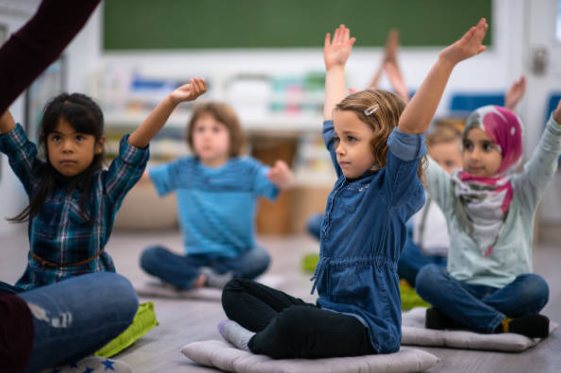3 Ideas for DPA in the Classroom

Previously published in Volume 83, Issue 2
When it comes to offering Daily Physical Activity (DPA) in our schools, it’s important not to confuse it with the teaching of physical education (Weatherson, Bradford, Berg, & Sloboda, 2016). DPA is a time for physical activity as opposed to a true focus on the type of learning that must exist in physical education programming.
Quality physical activity for students can happen in a variety of areas throughout the school (Bradford, Berg, & Hickson, 2015.) Even if the only space available is the classroom, DPA could include dance, fitness, games, gymnastics and/or individual activities. Therefore, it’s our contention that DPA can and should be offered in all schools, and that sharing DPA examples among teachers can help enhance DPA implementation.
Teaching considerations for DPA
When providing DPA throughout the school day, there are some important teaching considerations. According to Bradford et al. (2015), these include ensuring you don’t have more than the maximum number of participants to effectively run an activity, ensuring safety, and keeping noise levels in check. To avoid exceeding the maximum number of participants, teachers can divide students into small groups when possible, making sure to provide a sufficient amount of equipment for students to use. When considering safety, teachers must remove objects off the desks and around the playing area, and minimize running around the classroom. When it comes to noise level, teachers should promote alternative ways of communication (beyond verbal) such as clapping hands and using the thumbs-up signal.

Possible activities
In order to deliver DPA effectively, there should be a variety of activities employed throughout the school year. This will help keep students engaged and also encourage them to develop a broader range of fundamental movement skills. Activities could include individual activities such as running on the spot, push-ups, skipping and so on, or partner activities such as balancing games. Large groups might engage in a game such as passing a ball over and under from the front of the line to the back. A few examples are described in the following section (Bradford et al., 2015).
Individual Activities
1. ‘Future Athletic Champions!’ is an activity that asks students to stand next to their own desks. When the teacher calls out a sport skill (e.g., shooting a jump shot, serving a tennis ball, throwing a football, etc.), each student is asked to mimic the skill without any equipment for 10 to 15 seconds. The teacher should have a variety of skills written down so that the same skill is not repeated over and over.
2. ‘Ants in my Pants!’ is an activity that asks students to stand next to their desks. On the teacher’s signal, each student is asked to jog on the spot while wiggling their fingers. As the teacher continues to call out ‘Next,’ each student will perform the following activities in order (the progressions will occur every time the teacher calls out ‘Next’): wiggle their fingers and wrists; wiggle their fingers, wrists, and forearms; wiggle their fingers, wrists, forearms and elbows; wiggle their fingers, wrists, forearms, elbows and shoulders; wiggle their fingers, wrists, forearms, elbows, shoulders and hips; wiggle their fingers, wrists, forearms, elbows, shoulders, hips and knees; wiggle their fingers, wrists, forearms, elbows, shoulders, hips, knees and head.
Note: These individual activities don’t require any equipment.
Partner Activity
1. ‘Litter, Litter Everywhere!’ is an activity that asks partners to roll up one piece of paper and place it on the floor. The partners will then be asked to pick up the paper ‘ball’ using body parts called out by the teacher (e.g., elbow to elbow, foot to foot, knee to knee, foot to elbow, etc.).
2. ‘Scribble It, Just a Little Bit’ is an activity that asks partners to stand near a desk. Each set of partners will be asked to have one pencil and one piece of paper. When the teacher calls out a physical activity (e.g., jump, squat, jog on the spot, hop on one foot, etc.), each student will be asked to perform it (partners will perform the physical activities next to each other). After approximately 10 to 15 seconds of performing the physical activity, the teacher will call out a word from class (new terminology from science class, for example). The students will then be asked to stop performing the activity and work with their partners to spell the word on their piece of paper. After another 10 to 15 seconds, the teacher will call out another physical activity to perform. This sequence (e.g., performing a physical activity, writing a word from class, performing a physical activity, writing a word from class, and so on.) will continue until all the pre-selected words have been called out. During the cool down, the teacher can display the correct spelling of the words on the board in front of the room. At this time, the partners can check their spelling.
Note: The two partner activities, above, require minimal supplies.
Group Activity
1. ‘Hoop Circle’ is an activity that asks students, in groups of four to six, to stand in a circle facing each other. While each group member is holding hands with the individuals directly to the left and right, one hula hoop is placed between two students’ hands. Without releasing hands, the students will be asked to pass the hoop around the circle. A second hoop can be added, and the two hoops could travel in opposite directions.
2. ‘Group Juggle’ is an activity that asks students, in groups of five to eight, to stand in a circle facing each other. Each group will have a number of beanbags (at least one more beanbag than the number of group members). With the diameter of the circle being approximately three to five meters, one student will be designated as the ‘keeper of the objects.’ This student will be asked to choose one object and throw it across the circle (the object should not be thrown to the student next to the previous thrower). The student receiving the object will then throw the object to another group member until everyone has received and thrown the object once. The object should return back to the ‘keeper of the objects.’ This sequence of throwing must be remembered and followed in all future attempts. Once everyone knows the sequence, the ‘keeper of the objects’ will initiate the throwing sequence of the object again, but will also include a second object soon after the first. Eventually, all the objects should be in motion.
Note: These two group activities require minimal equipment.
Concluding thoughts
DPA during school can be an effective opportunity for physical activity, and is not to be confused with the teaching of physical education. In order to offer successful DPA experiences, and to ensure DPA doesn’t simply replace physical education instruction, we believe that teachers can benefit from additional support, resources and preparation. The activity examples shared in this article provide teachers with a few effective ways to begin or continue to implement DPA in the classroom, for students working individually, with partners or in groups.
More information
Try these resources for more help with DPA implementation:
- Alberta Education: Daily Physical Activity: A Handbook for Grades 1–9 Schools https://education.alberta.ca/media/160222/handbook.pdf
- Ever Active Schools: Daily Physical Activity
- Ontario Education: Daily Physical Activity in Schools (Grades 4-6) http://www.edu.gov.on.ca/eng/teachers/dpa4-6.pdf









